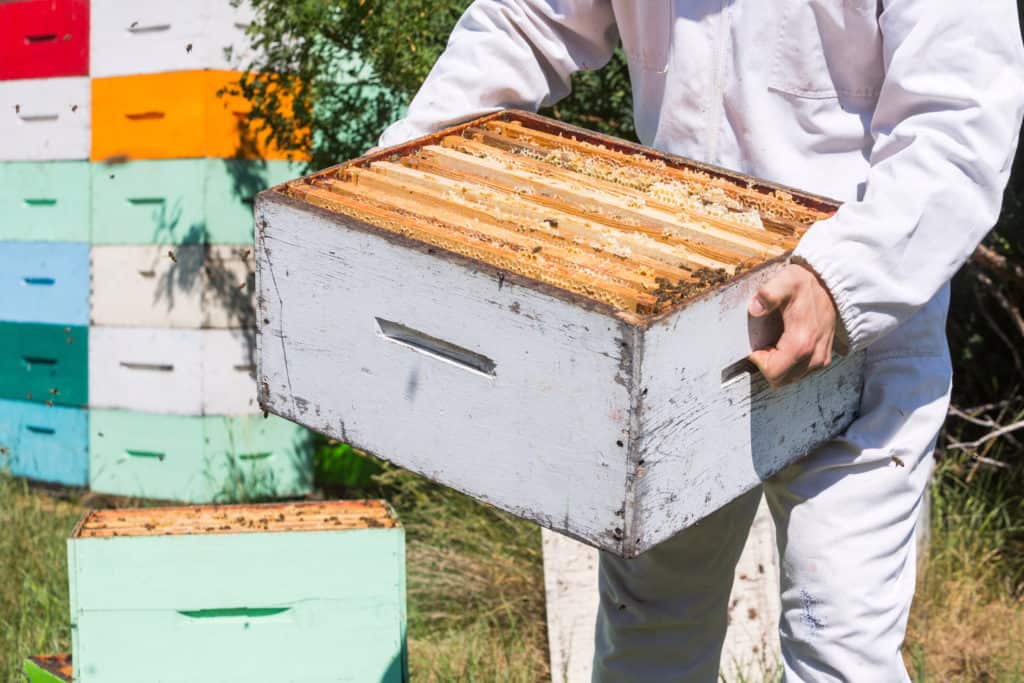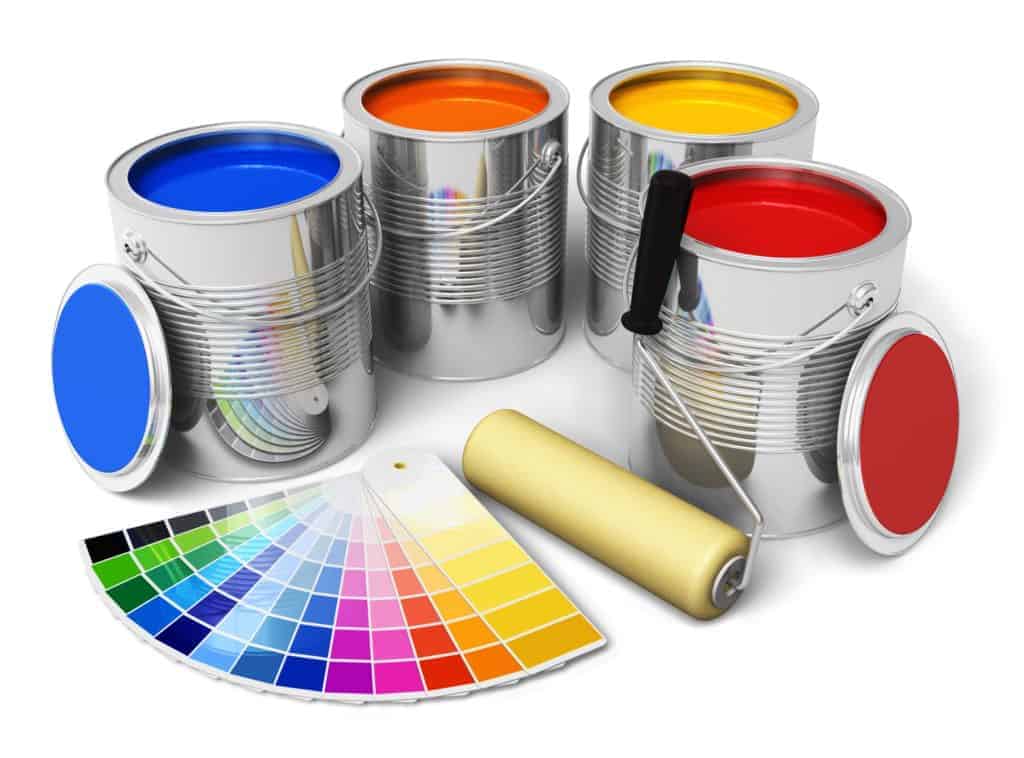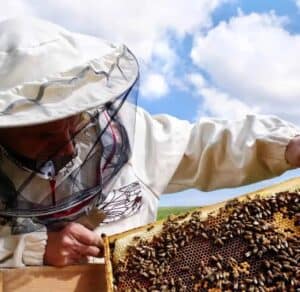Is There a Best Paint For Beehives? Is It Really Necessary?
If your looking into becoming a beekeeper, as a hobby or professional, you’ll be faced with this question: should I paint the beehive? Does it really matter?
The best paint for beehives is a water-based latex paint, rated for exterior use with low levels of VOC’s (volatile organic compounds). The VOC’s should be under 100 but ideally you want 50 or lower. This will protect your beehive against the elements while ensuring the safety of your bees.
There is several key factors you should consider when choosing the best eco-friendly paint: your budget, ongoing maintenance costs and most importantly the health of your honeybees.

Of all the wood finishes, a water based exterior paint offers the most protection against extreme weather conditions, and ultraviolet degradation for your beehives. Unfortunately, even the most eco-friendly exterior paints contain fungicides and low-biocide (Antimicrobial additives) exterior paints are not available.
The best choice is a water-based exterior paint that has zinc oxide as the fungicide. A water based paint is also better for the environment compared to the oil based alternatives.
Your next best option is acrylic, latex, or recycled water based exterior paints that contain zero to very low VOC’s. It is best to select a paint with under 100 VOC’s but below 50 is recommended.
Some beekeepers prefer to use wood stains for their woodenware because they prefer the natural look of the wood. But wood stains/treatments tend to contain higher levels of biocides, fungicides, and VOC’s. Although there are some stains made with beeswax or carnauba wax, they don’t offer the same level of protection as a good water based exterior paint.
It’s not recommended to use oil based exterior paints since they have the highest levels of VOC’s and are not eco-friendly.
The type of paint sheen: gloss, semi-gloss, or matte is really a beekeeper’s personal choice. To be practical, I would recommend either a gloss or semi-gloss finish since it is easier to clean than a matte finish.
Pro Tip: Latex surfaces stick to each other for a long time. Rub paraffin or beeswax on all the edges and reapply periodically to make it easier to separate boxes.
Even paints that have low VOC’s require a reasonable amount of time for the off-gassing process (curing time). The smell may not necessarily be harmful to your bees but can drive your bees away and interfere with the pheromone signals within the hive.
Before introducing your bees to your newly painted hive I recommend leaving plenty of time for the off-gassing process. Refer to the manufacturer’s label and add several days to the curing time for safety. The amount of additional time you wait will depend on your area’s temperature and humidity level.
Practically speaking, I would wait until you can’t smell the paint anymore then add a couple additional days before introducing your bees.
Overall, a water-based paint offers the best protection and longevity for your hives while being eco-friendly. This small but essential step will reduce your overall maintenance costs and lessen the impact of weather conditions on the health of your honeybees.
What Hive Surfaces To Paint

You should only paint the exterior surfaces of your hive box, especially corners (end grains and joints) and edges (top and bottom). You should never paint the interior of the boxes or anywhere the bees may touch such as entry ways, interior components and frames.
When painting your boxes apply more pressure to your paint roller on those corners and edges. You’ll get better coverage and fill any pockets that water can enter.
The corners and edges are where the boxes always begin to rot first. Water will sit on the edges between boxes and moisture will get into the wood. With changes in weather and temperature any wood with moisture in it will expand and swell. Your boxes will now rot very quickly.
Pro Tip: Paint sprayers are great for large jobs but always hand roll the corners and edges.
Bees are used to living in hollow logs and trees and prefer a more natural wood habitat. Keeping the interior unpainted better simulates the natural setting bees prefer.
Even low VOC paints contain some nasty chemicals that you don’t want your bees eating. But it’s unlikely the paint is going to effect the health of your bees. Beekeepers have painted the interior of their hives in the past with no effect on their bee’s health.
⚠️The most important reason to not paint the interior of your woodenware is to avoid having paint and chemicals in your honey.
It is recommended to apply 2 coats of paint with a primer already mixed in. This will reduce your cost and painting time. One good application of paint and your boxes should last approximately 10 years.
Pro Tip: Repainting your boxes every 3-4 years extends the life of your woodenware 15-20 years.
Some beekeepers suggest to never paint any surfaces of your bee boxes. They believe this will better simulate the honeybee’s natural environment. I don’t recommend this practice because it’s impractical and not cost effective. Your woodenware will be lucky to last 3-4 years with the constant exposure to weather conditions. Further, as the boxes degrade, they become incredibly difficult to work with, and can expose your bees to adverse weather conditions.
Beekeeping is expensive and you want to protect the investment into your equipment. Paint is a far more cost-effective way to extend the life of your boxes. You don’t want to be replacing bee boxes every 3-4 years. This is very expensive and not practical.
What Color To Paint My Beehive

White is the most common color used for beehives. A lighter color, such as white, is used for better temperature regulation in warmer climates. In using a lighter or reflective color, less sun is absorbed in the summer months thereby keeping the hive interior more comfortable for the bees.
In colder regions a darker colored paint, such as green or brown, is used to absorb more of the sun during the winter. This will keep the interior of your hives warmer throughout the winter. By keeping your hives warmer in the winter, the bees require less honey to survive until the spring.
Although, if you keep your hives in the shade and lower their exposure to the sun, the color of the exterior paint won’t affect the internal temperature.
Paint color is often used to help the beehives blend into their surroundings. This is especially common in more populated/suburban areas where beekeepers will choose a color to match their house or surrounding buildings. Whereas in more rural areas you’ll often see boxes painted to match the surrounding greenery.
It is also common to use different paint colors to keep your bee boxes organized. As your collection grows this practice is recommended since it’s hard to tell certain sizes apart such as: mediums and shallows. This will assist you in telling the different sizes apart quickly and efficiently.
Practically speaking, your honeybees don’t really care what color you paint the hive. Although, larger beekeeping operations will use different paint colors at the front of their hives to help reduce drift. It is believed this makes it easier for bees to locate their hive when all the hives look the same and pheromones are intermingled.
What Does It Cost To Paint Hives

Painting your hives is one of the most inexpensive costs for beekeeping. One quart of paint will cover approximately 15 medium bee boxes with 2 coats of paint. Depending on the type of paint you buy it will cost from $12 to $20 per quart. On average, it will cost you approximately $1 per medium box to paint.
Here’s a couple common & affordable exterior paints that satisfy all recommendations: Low Oder – Low VOC’s, Paint + Primer & Water Based.
- Valspar SeasonFlex Ultra – $12-14 per quart depending on sheen and available at Lowes.
- BEHR Premium Plus – $14-$16 per quart depending on sheen and available at Home Depot.
If you prefer to use a wood stain, here is an option with low VOC’s but it is more expensive than the paints listed above:
- PolyWhey® Exterior Penetrating Wood Stain – $20 per quart and available at Vermont Natural Coatings
Should I Hot Wax Dip My Beehives
This is generally not an option for the beekeeping hobbyist. This is more popular with larger beekeeping operations that are tired of painting boxes and can afford the upfront costs.
Advantages:
- Is a wood treatment – expelling moisture from your woodenware. Rather than just treating the exterior of the wood with paint.
- Treatment of the exterior and interior surfaces.
- Sterilizes equipment by killing AFB spores.
- Requires only 1 treatment – no repainting.
- The boxes are ready to go once they dry.
- Extends life of equipment to 15-20 years
Disadvantages:
- More expensive
- Requires additional equipment & expertise.
- Dangerous – you need to very careful when mixing and heating wax. If you get above a certain temperature it will ignite.
It is a fairly simple process that requires a 2:1 mixture of Paraffin wax to Microcrystalline wax. The wax is heated between 250-300 Fahrenheit and the boxes are submerged for 10-15 mins depending on preference. The moisture within the box boils out (as foam) and the wax gets sucked into the wood.
Pro Tip: You can paint your woodenware immediately after removing from the wax dip. Just be quick because once the box cools and the wax dries the paint won’t adhere.
Check out this video – it’s a great demonstration of how to wax dip your bee boxes.
It is recommended to dip your boxes after assembly. Otherwise the wax prevents the glue from adhering to the wood. There’s several people online that offer this service but you will have to check your local area for cost and availability.
Related Questions
What is the Best Wood for Beehives? The best wood for beehives is a good select grade premium pine. Pine lumber is easy to work with, it’s available everywhere in North America & Europe, and it’s the most affordable. Your pine bee boxes will last decades if properly treated and looked after.
Can Honeybees See Color? Bees can see yellow, orange, blue-green, blue, violet and purple. Bees cannot see red because they don’t have the photoreceptor for it. The most likely colors to attract bees are blue, purple and violet.
How High Off The Ground Should Beehives be? Place your beehives 4-6 inches off the ground. Most beekeepers place their hives on wooden pallets. Pallets can handle the weight of multiple boxes and keep your bottom board from sinking into the ground. This is very important during the honey flow.

Joseph Davis
My goal is to show that anyone can take up beekeeping and it can be a very rewarding hobby. I strive to share my experiences and answer any questions you may have.
